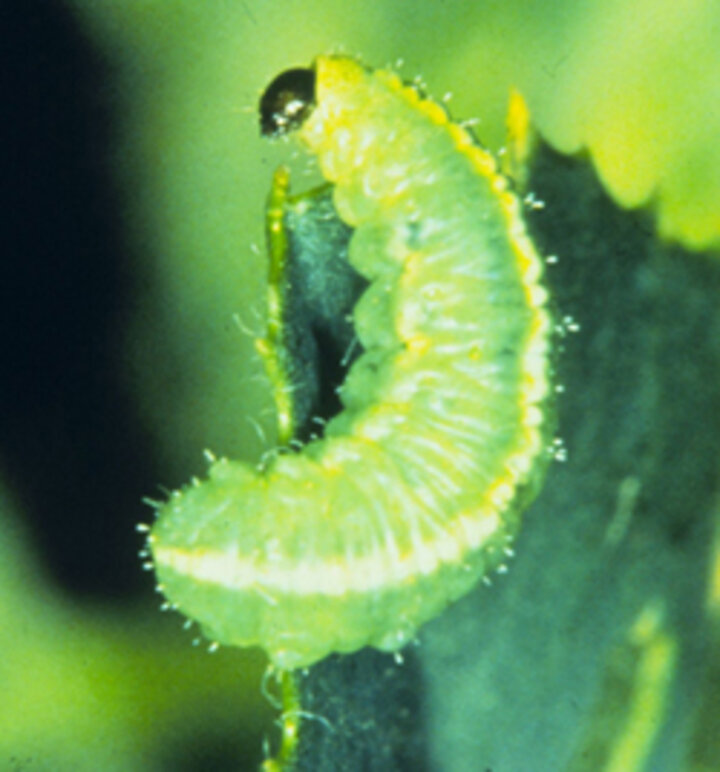May 9, 2008

|
| Alfalfa weevil |

|
| Clover leaf weevil |

|
| Alfalfa weevil damage. |
Insect development has been delayed in Nebraska due to below average temperatures. However, with temperatures climbing and alfalfa greening up, it is time to begin scouting alfalfa for weevils and signs of feeding damage. Temperatures and conditions in southern Nebraska indicate that some feeding may be observed as tiny pinholes on the leaves of the upper part of the stem.
One way to quickly scout a field for alfalfa weevils is to use a sweep net. A 15-inch diameter net is a useful tool for establishing the presence of insect pests and is essential for some, including the potato leafhopper in alfalfa, which cannot be scouted accurately by any other method. Field sweep nets are available through many agricultural suppliers, including Great Lakes IPM, Gemplers, Forestry Suppliers, Bioquip, and others. They cost $30 - $50. Replacement nets also are available.
Most alfalfa weevils overwinter as adults and then become active and lay eggs; however, some overwinter as eggs and hatch early. This has resulted in some areas in Nebraska (Panhandle and the northern tier of counties) being hit with two flushes of weevils in spring. In recent years alfalfa weevils in some areas have damaged regrowth after the first cutting due to a combination of late larval feeding and adult feeding. This is something to be aware of after the first cutting.
While alfalfa weevil damage has been spotty in much of Nebraska over the past few years, the potential for damage always exists. If you're growing high quality alfalfa hay, in the next few weeks take time out from planting row crops to scout for weevils.
| Table 1. Comparison of alfalfa weevil to clover leaf weevil. | |
| Alfalfa Weevils | Clover Leaf Weevils |
| Overwinter primarily as adults | Overwinter primarily as larvae |
| Adults brown with dark brown stripe halfway down back, 3/16 inch long | Adults dark brown, pitted light brown underneath, over 1/4 inch long |
| Larvae prefer to feed on tips | Larvae feed anywhere on plant |
| Larvae remain on plant most of the time | Most larvae in soil or debris during daytime hours |
| Larvae have black heads | Larvae have brown heads |
| Adults leave fields in June | Adults may remain in fields |
Clover leaf weevils (CLW) are occasionally a problem but are very vulnerable to fungus disease and so haven't been pests since the late 80s early 90s when spring rains were rare. Dry conditions over the past several years in western Nebraska likely were conducive to building their populations, although recent rain could have knocked populations down. Clover leaf weevil larvae will be in the debris around the crowns during day. Scratching in the soil around the crowns and counting the number of larvae found per crown will help give a better idea of clover leaf weevil infestation. Their brown heads will help distinguish them from the black-headed alfalfa weevil. Table 1 compares the alfalfa weevil and the clover leaf weevil.
Both the alfalfa and clover leaf weevils feed on first cutting alfalfa as larvae, and regrowth after the first cutting as adults (and sometimes larvae). While research in northeast Nebraska has shown that clover leaf weevil larva feeding does not cause yield reduction to first cutting alfalfa, alfalfa weevil feeding can cause severe losses to yield and quality of the first cutting.
Scouting for Alfalfa Weevils
It is essential that fields be monitored now for alfalfa weevil feeding. Damage consists of small holes and interveinal feeding on the newest leaflets near the stem tips. The larvae are a small (1/16 to 3/8 inch in length), pale yellowish green, becoming a darker green when larger. These legless worms have black heads and a white stripe the length of the back. The alfalfa weevil larvae spend nearly all their time on the plant. When disturbed, they curl into a "C" shape.
Once the alfalfa is about 4-6 inches tall, take a net sample to establish whether weevils are present. If they are, carefully cut some stems at ground level (30 to 50 per field, from various spots in the field) and shake the stems against the side of a 5 gallon bucket. This will dislodge the weevils and make it easy to average the number of weevil larvae per stem.

|
| Figure 1. Treatment thresholds for the alfalfa weevil at three alfalfa price levels. |
Each chart has been developed for a different alfalfa value. To treat or re-sample depends on the average number of weevils per stem, the stem length, and the value of the alfalfa. When alfalfa reaches a certain height, it may be more profitable to cut the alfalfa early rather than treat it. Insecticides registered to control alfalfa weevil larvae include Ambush, Baythroid, Cythion, Furadan, Guthion, Imidan, Lannate, Lorsban, Mustang Max, Penncap M, Proaxis, Pounce, Sevin, and Warrior. Check the labels or see UNL's Entomology Web site at http://entomology.unl.edu/instabls/instabls.htm to find the use rates.
Keith Jarvi
Extension IPM
Northeast REC, Norfolk
Tom Hunt
Extension Entomologist
Haskell Ag Lab, Concord
Robert Wright
Extension Entomologist, Lincoln
